Today we have another interesting motherboard from Supermicro based on the X11 platform, the X11SSQ. This motherboard is well suited for ATM, Kiosk, NVR/DVR Surveillance, Medical, Storage or Server appliance and many other embedded applications including small workstations. Low power use, ample video output options and complete storage solutions that allows it to fit into just about any small form factor case. The Supermicro X11SSQ-O uses Intel’s new 6th Gen Core i3/i5/i7 processor family (Skylake architecture) and DDR4 memory which can give this platform a big processing power punch.
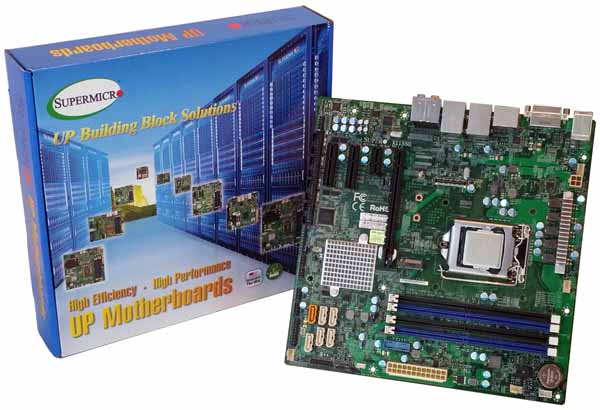
Supermicro X11SSQ motherboard Key Features
- Single socket H4 (LGA 1151) supports Intel 6th Gen. Core i7/i5/i3 series, Intel Celeron and Intel Pentium processors
- Intel Q170 Express chipset
- Up to 64GB DDR4 2133MHz Non-ECC Unbuffered UDIMM; 4 DIMM slots
- 1 PCI-E 3.0 x16, 2 PCI-E 3.0 x4, 1 PCI-E 3.0 x1, M.2 PCIex2 M Key 2242/2280, PCIex4 w/ open slots
- 1x GbE LAN w/ Intel i210-AT, 1x GbE LAN w/ Intel PHY i219LM
- 6x SATA3 (6Gbps) via Q170; RAID 0, 1, 5, 10 Intel RST
- HDMI, DP, DVI-D, 1 eDP, Intel HD Graphics, 3x independent displays
- 1x SATA DOM, 4x COM ports, TPM header, ALC 888S HD Audio 7.1
- 4x USB 3.0 (2 rear + 2 via header), 8x USB 2.0 (4 rear + 4 via headers)
- Micro-ATX form factor, 9.6″ x 9.6″, (22.4cm x 22.4cm)
Close look at the Supermicro X11SSQ Micro-ATX motherboard
The accessory package that comes with the X11SSQ includes SATA cables and the I/O back plate.
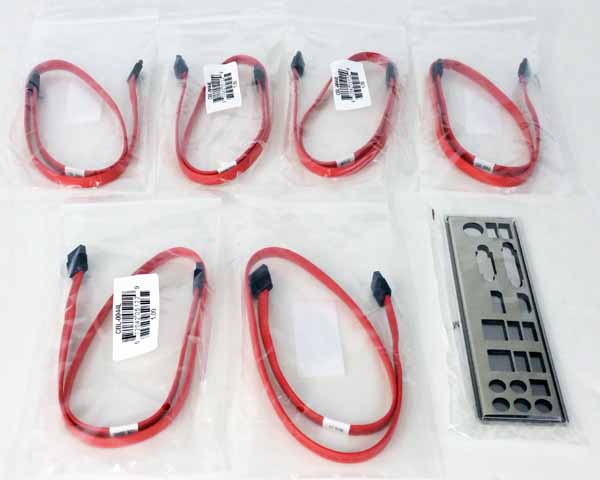
Accessories:
- 6x SATA 6Gb/s cable(s)
- Standard I/O Shield
Drivers and manuals can be found on supermicro’s website. For these types of boards we do not find it nessecory to include these with the retail motherboard kit.
The block diagram for the X11SSQ is as simple as it gets, yet it offers a large number of features with the PCH Q170 chipset.
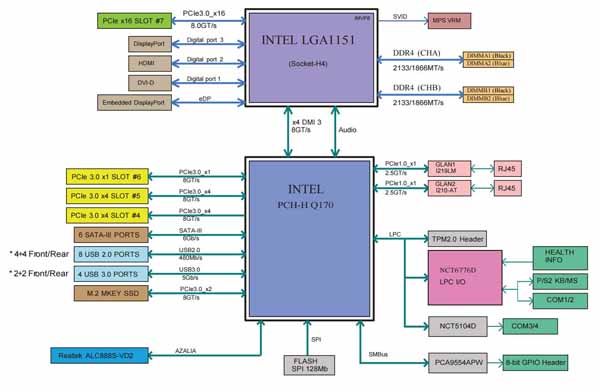
The Intel 6th Generation Core i7 and PCH Q170 platform supports the following features:
- Intel AMT 11.0, TXT and vPro
- PCI-E 3.0, SATA 3.0, USB 3.0
- Intel Hyper-Threading, Intel VT-D, VT-x, SR-IOV
- TSX-NI, AES, SGX
- Intel Turbo Boost Technology
- Intel Rapid Storage Technology
- DDR4 Memory Support up to 2133MHz 64GB
- Three independent Graphics Displays with Audio Stream, VP8, VP9, HEVC, OpenGL 4.3/4.4, Intel Quick Sync Video Technology
Let’s move on to the X11SSQ motherboard itself.
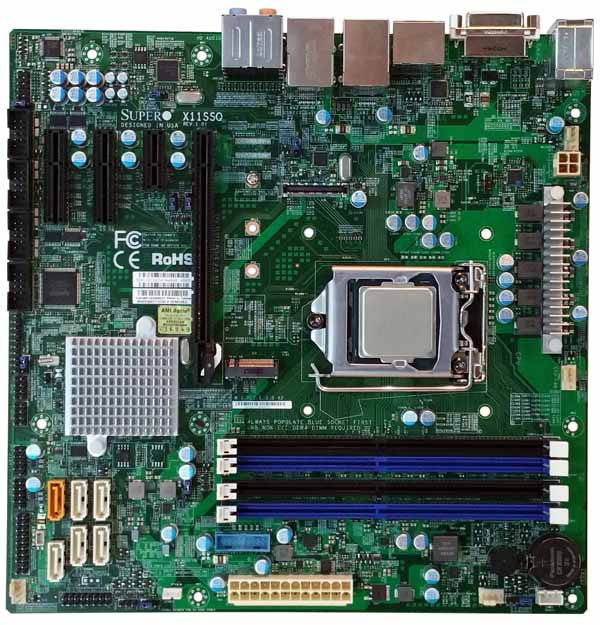
Supermicro’s single processor socket H4 design with the Q170 embedded chipset allows for very compact motherboard designs, in this case a Micro-ATX form factor. Ample storage and display outputs are the hallmark of this motherboard. Just to the left of the CPU we find an M.2 PCIex2 M Key SSD slot which offers a powerful storage solution for installing an operating system onto, if this is all you need for storage the full system can be run from here allowing the X11SSQ to be installed into very compact systems.
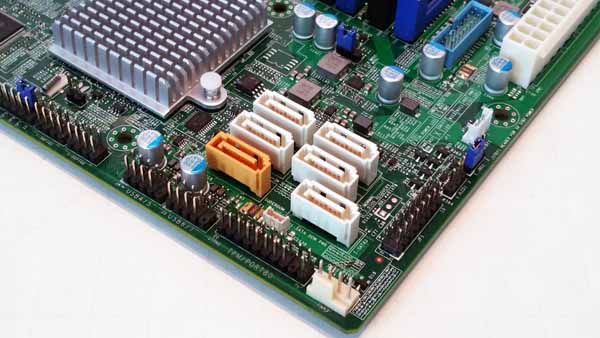
The storage ports include 6x SATA 3.0 (6Gbps) ports that are supported by the Intel Q170 chipset. These support RAID 0, 1, 5, 10.
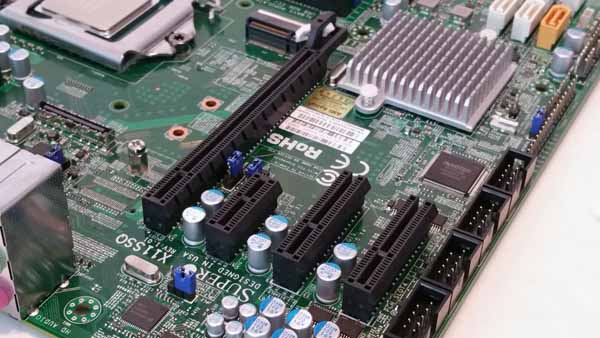
Looking at the PCIe 3.0 slots we see 1x x16 slot, 2x x4 slots and 1x x1 slot. The x16 slot is suitable for running a graphics card.
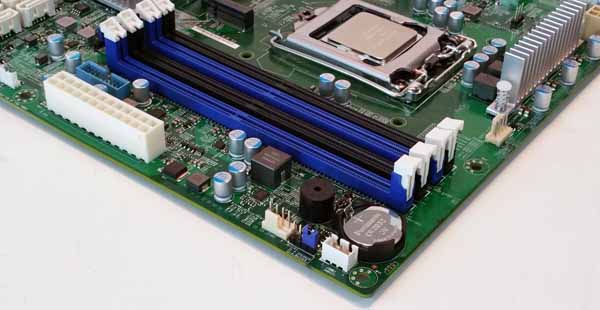
Memory slots are configured as 4x 288-pin DDR4 DIMM and can use Up to 64GB DDR4 ECC UDIMM 2133/1866 MHz or Non-ECC DDR4.
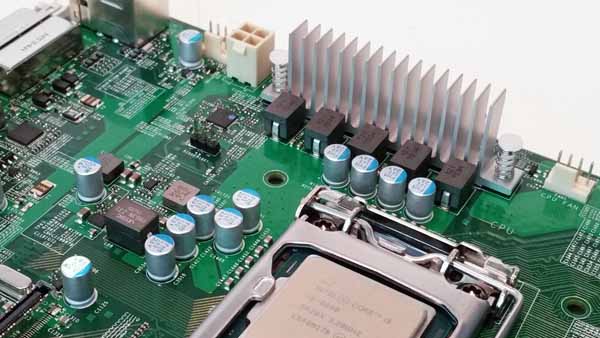
Small and compact power circuits allow for cool running systems. Right next to the heat sink is a +12V 4-pin CPU Power Connector.
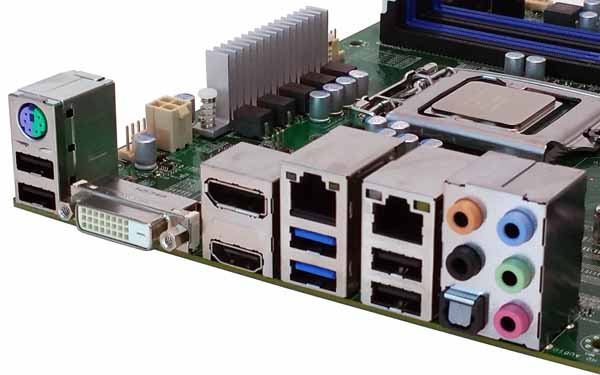
The back IO ports on the X11SSQ-O allow for 3 displays with HDMI, DP and DVI-D ports. USB ports are 4x 2.0 and 2x 3.0 ports. Network connectivity is provided by single Intel I210-AT Gigabit Ethernet LAN port and a single Intel PHY I219LM Gigabit Ethernet LAN port. Audio is 7.1 HD RealTek ALC 888S High Definition Audio.
BIOS
When booting for the X11SSQ we find a new Supermicro splash screen which is probably more compliant with standard Supermicro branding than old versions.
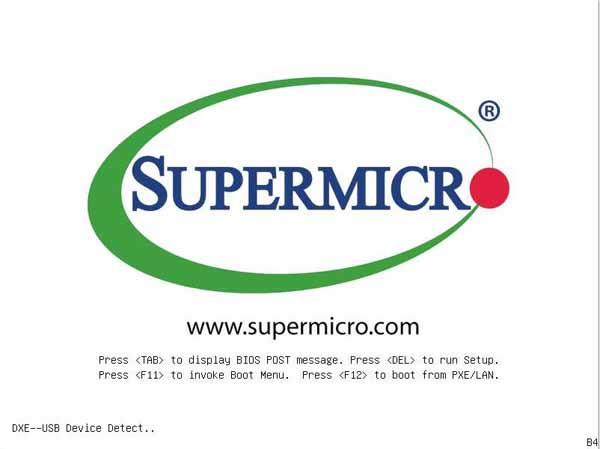
This new splash screen offers the same functionality as any Supermicro board offers (e.g. Press <DEL> to get into the UEFI BIOS.) Here we can see some features that can be fine-tuned or activated with normal BIOS operation. The BIOS is very typical of other Supermicro boards and you should have no trouble getting around inside it.
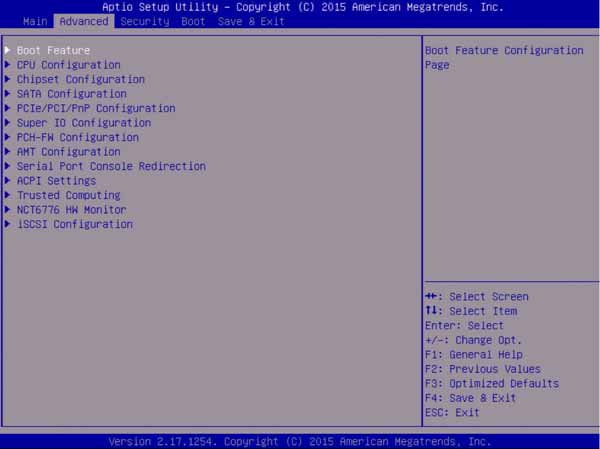
One can see the setting for AMT configuration in the BIOS screen. This is important if you are using AMT features/ vPro. We covered previous generations of Intel vPro and the concepts are largely the same.
Our test setup
For testing we used:
- CPU: Intel Core i5-6500 Skylake
processor (4 Cores) no Hyper-threading
- Motherboard: Supermicro X11SSQ-O
- Memory: Crucial 4x 4GB DDR4
non-ECC RAM (16GB Total)
- Cooling: Standard Intel Stock Heat Sink
- Storage: Micron P400e 200GB SSD
- GPU: Nvidia K5200
and Tesla K40
- OS: Windows 8.1 and Ubuntu 14.04
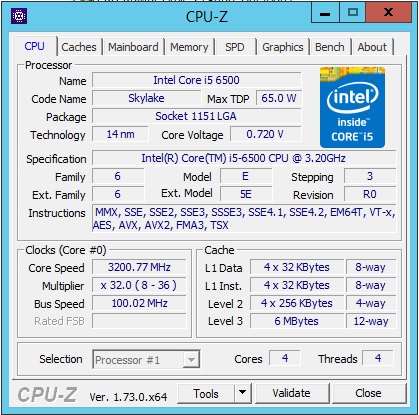
Here we see the CPUz screen shot of the Skylake i5-6500 processor. This processor does not support hyper-threading so we only see 4 cores. It does h
AIDA64 Memory Test
AIDA64 memory bandwidth benchmarks (Memory Read, Memory Write, and Memory Copy) measure the maximum achievable memory data transfer bandwidth.
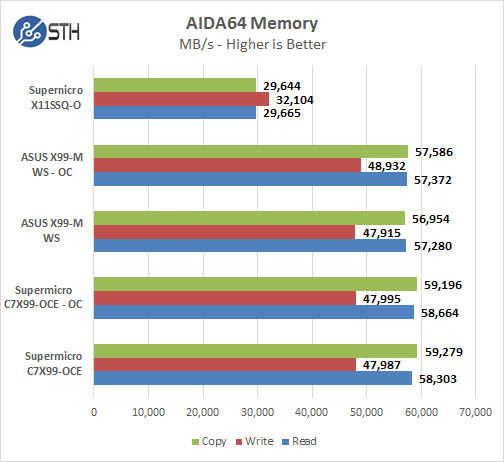
Memory Latency ranged at ~67.6 ns with our 4x 4GB (16GB Total) DDR4 memory sticks installed. Our tests showed about half the bandwidth vs a 5960x we used in our other tests, this is impressive in itself, that a 4 core Skylake processor can get memory speeds at half with much more powerful systems can do.
Linux-Bench Test
Our Linux-Bench is a test suite scripts common Linux benchmarks and provides a consistent and easy to run methodology. One can compare these tests to hundreds of other configurations in the Linux-Bench database but also with sites such as Tom’s Hardware and Anandtech that use the script.
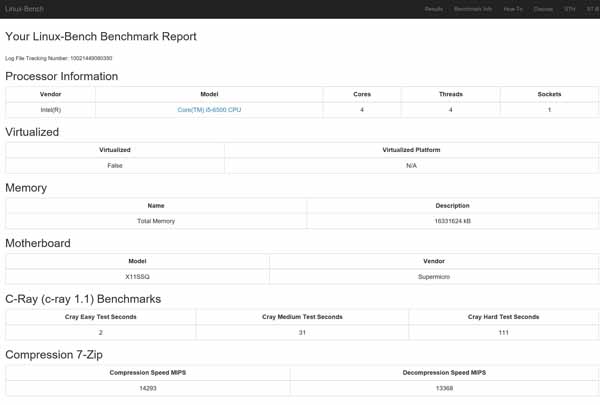
The example of full test results for our Linux-Bench run can be found here: Supermicro X11SSQ Linux-Bench Test Results
SPEC CPU2006
SPEC CPU2006v1.2 measures compute intensive performance across the system using realistic benchmarks to rate real performance.
In our testing with SPEC CPU2006 we use the basic commands to run these tests.
” Runspec –tune=base –config=servethehome.cfg ,” then ” int ,” or ” fp .”
To do multi-threaded, we add in ” –rate=4.”
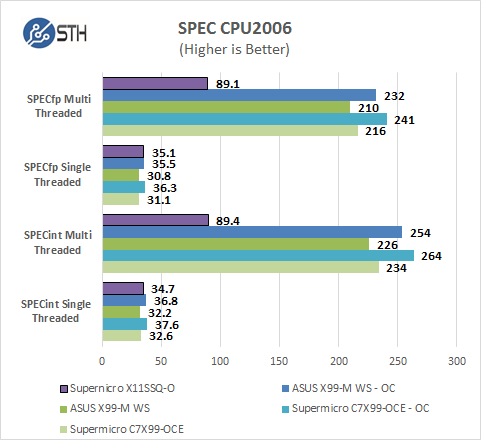
Single threaded performance stacks up very well on the Skylake i5-6500 processor and that is this processors strong point. Of course without hyper-threading it cannot compete with a 5960x but it’s single threaded compute power gives this system a pretty good punch and is more than adequate for these types of systems. Of course the X99 motherboards are very different platforms, but we wanted to show a bigger comparison (e.g. what you get with a significant step up.)
Power Tests
For our power testing needs we use a Yokogawa WT310 power meter which can feed its data through a USB cable to another machine where we can capture the test results. We then use AIDA64 Stress test to load the system and measure max power loads.
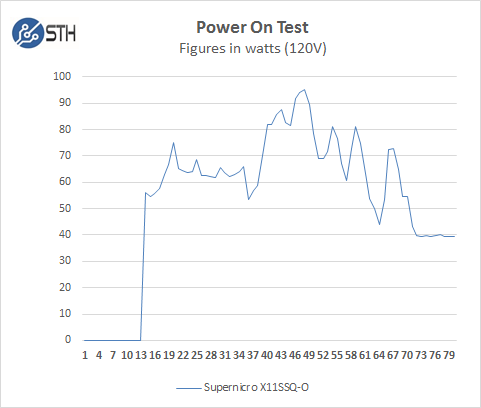
The X11SSQ does not come with IPMI or an AST2400 based remote management BMC so system power is at zero in the off state. The system boots up and jumps to a peak of about 95 watts including the K5200 we had installed. After the system initializes it settles down to about 40watts power use at idle. The Skylake i5-6500 processor has a low TDP of 65 watts so this makes for a nice cool running system. If we run the system without the K5200 idle power use was around 30 watts which makes the X11SSQ-O even more attractive for low power uses.
Fully Loaded Stress Tests Power Use
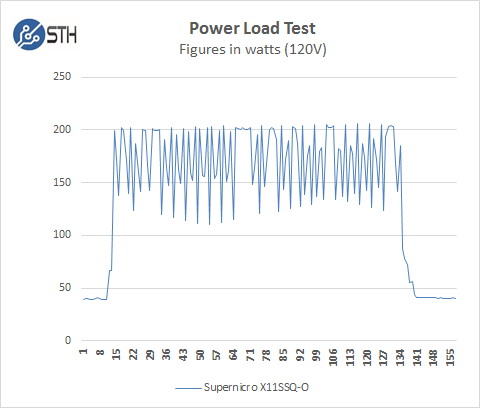
For our tests we use AIDA64 Stress test which allows us to stress all aspects of the system. At default BIOS settings we see about 200watts at max power use including the K5200. We also tested the system without the K5200 and found total system power use to be around 50 watts.
Conclusion
The X11SSQ is an amazing motherboard when you consider all the video output options that this system comes with, low power use and capabilities to expand with higher-end graphics cards.
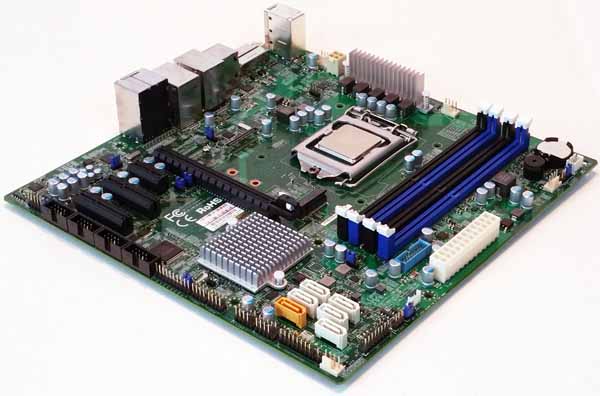
Small form factor motherboards like the Micro-ATX X11SSQ-O make great systems that can be easily expanded to increase performance in the graphics area. This board does have a lot of different video outputs, HDMI, DP, DVI-D, Intel HD Graphics, 3x independent displays, but two that are more common are missing, that is DVI-I or even simple VGA. We would say scrap the DVI-D and give us DVI-I or VGA and this board would be all set to handle a larger number of display types.


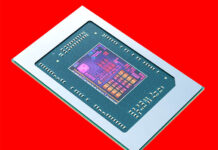
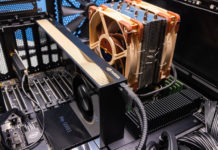
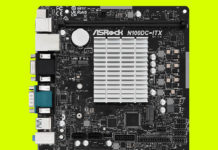
I don’t think skylake has any analog outputs to support DVI-I or VGA which is probably why the last server we ordered had DP only as it’s video out.
Article states both ECC and non-ECC RAM can be used. It’s probably non-ECC only, correct?
The image shows PCIe x2 interface to M.2 and the text bullet earlier claimed it to be x4?
The manual for the X11SSQ indicates on p.50 that the M.2 connector is a “PCI Express 3.0x 2 interface”. The same is true for my X11SSH-F 1151 UP Xeon board. It looks like SM has used x2 for M.2 across the X11 line.
Is it worth it to get an x4 card (like the Samsung 950 Pro) if the board only runs it at x2? That’s still a 33% increase over Sata6, but perhaps not worth the extra trouble (drivers) vs. just getting a Sata6 ssd.
Could you please test (if possible) whether this motherboard will work with intel pro/1000 quad nic? like, for example, Dell H092P PRO/1000 VT Quad-Port.
I know it’s pretty old but this only makes it more appealing for home routers like pfSense since market is flooded with them used for a good price. And I’m asking because I have one of them myself, and it was running fine on J1900 matx board, but then I realised that this platform is capped at x1 pci-e although slot was x4 electricly. And as the matter of fact it resulted in half speeds for storage applications and overall low responsivnes in HTTP(S).. So I went and upgraded to similar form-factor Skylake platform (G4400 + B150 ASUS mobo). Then I found out that NIC just wont work with it (there is power, it even links cables, but no act signals and not recognised by board).
So I am really curious if should get something like I350-T4 or should have waited and bought proper server class board like this one?